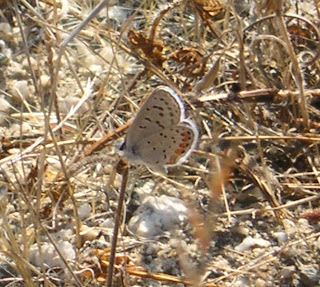Pebble Beach - from the Pacific Grove Asilomar entrance
August 29, 2009
August 29, 2009
We walked through Pebble Beach for over 4 hours, covering approximately 8 miles, on this lazy Saturday afternoon. It was extremely hot inland (read: over 100 degrees Fahrenheit), so we preferred to stay along the coast where it was relatively cooler. The walk was nice, save for the part of trying to figure out how to get around the numerous golf courses.
We spent most of our time gawking at the tourists who pay $9.50 to drive through 17-Mile Drive and enjoying a couple $3.5-4.5 million dollar Eric Miller open houses. I suspect in 50 years, Eric Miller will be lauded for shaping the local architecture. For those who are not familiar, an "open house" is a very common weekend occurrence in the area where realtors show houses they're trying to sell; it's free and has become sort of a hobby of mine to stop while walking through town. Just like with nature, I prefer looking rather than... um, collecting (it helps that I don't have $3,500,000 to spend). My love for residential design could be the subject of another blog considering I have easily toured over 150 open houses in the past few years.
Yep, I'm getting off-subject with this post, but it's quickly progressing towards the blah seasons for me. I find I'm not wanting to carry the camera with me on my hikes now. I absolutely love spring here and hope in the coming weeks I'll have time to go through my photo archives and predate blog posts to fill-in the first-half of 2009. Unfortunately, predated posts may not show in the blogger reading list - I haven't figured out how to get around that since my post dates reference to when I observed nature in action, not when I happened to be online to write about it.
Alright, getting back to nature topics... Hickman's potentilla and Yadon's piperia are federally protected species within the Pebble Beach boundaries. Vern Yadon was the Museum Director in Pacific Grove for many years. It is thanks to him that we have the humble, yet impressive annual wildflower show every April. I did a little research and I believe our local wildflower show at PGMNH may very well be the 2nd largest in the world in terms of number of species represented. I'm proud!
Much of the coastline in Pebble Beach is very similar to Pacific Grove. I hold no conniptions that Sunset and Ocean View are considered the "poor-man's 17-Mile Drive." We love to drive the coast on the way home from the grocery store and I don't feel poor at all. I am very blessed to live here.
We spent most of our time gawking at the tourists who pay $9.50 to drive through 17-Mile Drive and enjoying a couple $3.5-4.5 million dollar Eric Miller open houses. I suspect in 50 years, Eric Miller will be lauded for shaping the local architecture. For those who are not familiar, an "open house" is a very common weekend occurrence in the area where realtors show houses they're trying to sell; it's free and has become sort of a hobby of mine to stop while walking through town. Just like with nature, I prefer looking rather than... um, collecting (it helps that I don't have $3,500,000 to spend). My love for residential design could be the subject of another blog considering I have easily toured over 150 open houses in the past few years.
Yep, I'm getting off-subject with this post, but it's quickly progressing towards the blah seasons for me. I find I'm not wanting to carry the camera with me on my hikes now. I absolutely love spring here and hope in the coming weeks I'll have time to go through my photo archives and predate blog posts to fill-in the first-half of 2009. Unfortunately, predated posts may not show in the blogger reading list - I haven't figured out how to get around that since my post dates reference to when I observed nature in action, not when I happened to be online to write about it.
Alright, getting back to nature topics... Hickman's potentilla and Yadon's piperia are federally protected species within the Pebble Beach boundaries. Vern Yadon was the Museum Director in Pacific Grove for many years. It is thanks to him that we have the humble, yet impressive annual wildflower show every April. I did a little research and I believe our local wildflower show at PGMNH may very well be the 2nd largest in the world in terms of number of species represented. I'm proud!
Much of the coastline in Pebble Beach is very similar to Pacific Grove. I hold no conniptions that Sunset and Ocean View are considered the "poor-man's 17-Mile Drive." We love to drive the coast on the way home from the grocery store and I don't feel poor at all. I am very blessed to live here.


